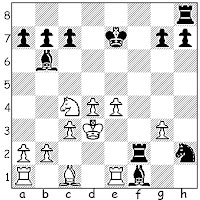1.e4 e5 2.Nf3 Nc6 3.Bc4 Bc5 4.Bxf7+ ...and related lines
(risky/nonrisky lines, tactics & psychology for fast, exciting play)
Saturday, December 15, 2012
Thinking again...
Despite my initial skepticism about Black's chances in the line Yury Bukayev recently asked me about, 1.e4 e5 2.Nc3 Nc6 3.Bc4 h6 4.Nf3 Nd4 (a line I once dismissively suggested transposed to "the Improved Blackburne Shilling Jerome Gambit" after 5.Bxf7+), further examination indicates that things can get pretty tricky for White, if he does not respond properly.
Certainly White can simply 5.0-0 and have the better game (because of his lead in development), but the question arises: does the addition of Nb1-c3 for the first player "detoxify" the dangerous-in-the-original-Blackburne-Shilling-Gambit move 5.Nxe5? Of course, Black will respond with 5...Qg5.
Here, as with the original BSG, the greedy 6.Nxf7 leads to all sorts of complications and inevitable pain for White: 6...Qxg2 7.Rf1 d6 and Black's threat of ...Bg4 means that the first player doesn't even have time to win the Rook, safely (check out 8.Nxh8 Bg4 9.f3 Be7! 10.Ng6 Bxf3 11.Nxe7 Bxd1 12.Nf5 Nxf5 13.Rxf5 Bxc2 as one example, where White does not get enough for his Queen).
He can carry on with 8.Nd5 Bg4 9.Ne3 Bxd1 10.Nxg2 Bh5 11.Ne3 Bxf7 12.Bxf7+ Kxf7 where White has a pawn for his sacrificed piece. Clearly it is not a line to go into voluntarily, if there are alternatives!
There is also the defensive-minded 6.Ng4, which can lead to either messy or kempt positions where White has two pawns for his piece: 6...d5 7.Nxd5 Qxg4 8.0-0 (or the messy 8.Nxc7+ Kd8 9.Nxa8 Nxc2+ 10.Kf1 Nxa1 11.Bxf7 Kc8 when both a-Knights are likely to eventually expire) Qxd1 9.Rxd1 Bd6 10.Ne3 Be6.
My preference, until recently, has been 6.Bxf7+, since after 6...Kd8 White can play 7.Ng4 and answer 7...d5 with 8.Ne3, covering the White g-pawn.
Of course, not everyone will agree with me. In fact, in my next post I will share a very educational email from Yury, taking this discussion in a new direction!
Thursday, December 13, 2012
What do you think?
About a month ago, Yury Bukayev asked me about the following line of play: 1.e4 e5 2.Nc3 Nc6 3.Bc4 h6 4.Nf3 Nd4.
It had a certain familiarity to it, especially since he suggested 5.Bxf7+!? as a response.
I told him that I would share the opening and my thoughts about it with Readers.
In the meantime, I went to the online ChessLab site and searched for games with the line. I found exactly zero.
Silly me, I was looking in the wrong place. A check of the 26,685 games in The Database showed me 10 examples (White won 9).
One was Wall - Surr, Chess.com, 2010 (1-0, 11), which has already appeared on this blog.
So, clearly, it was time for me to pay attention. First, a brisk walk-through.
1.e4 e5 2.Nc3 Nc6
Starting out as a Vienna Game.
3.Bc4 h6 4.Nf3
The game has transposed to a Semi-Italian Opening, i.e. 1.e4 e5 2.Nf3 Nc6 3.Bc4 h6 4.Nc3 (I usually play the alternative 4.0-0).
4...Nd4
Reaching the diagram above.
This Knight move is seen in the Blackburne Shilling Gambit: 1.e4 e5 2.Nf3 Nc6 3.Bc4 Nd4. The idea in the BSG is that White's greedy 4.Nxe5 can be met by 4...Qg5.
Then the classic BSG punishment by Black follows 5.Nxf7 Qxg2 6.Rf1 Qxe4+ 7.Be2 Nf3#. The pluckier 5.Ng4 is met by 5...d5, with Black advantage. "Best" at this point for White might be 5.Bxf7+ followed by 6.0-0, When Black has the advantage of a piece for two pawns, but many Jerome Gambiteers would be used to that.
Of course, against the Blackburne Shilling Gambit, many Jerome Gambiteers would reply with 4.Bxf7+!? to begin with.
Can the Knight jump work for Black in the delayed form, however? What do you think?
Tuesday, December 11, 2012
Once Again Into the Fray
I have mentioned earlier (see "Only Seemed Fair" and "Through To Two" for two accounts) my participation in a couple of Chess.com's Italian Game thematic tournaments where opportunities to play the Jerome Gambit (1.e4 e5 2.Nf3 Nc6 3.Bc4 Bc5 4.Bxf7+) surfaced.
In one tournament I failed to advance (see "You have been eliminated") but in the other, I have just started the second round in a 4-player group, alongside two 3-player groups.
As always, I will do my best to uphold the, ahem, good name of the Jerome Gambit (while trying not to make a fool out of myself), and will share my games with readers, come what may.
I am again matching wits with JoseSoza, whom I defeated in the first round with the Black pieces (against his Evans Gambit), but who defeated my Jerome Gambit, giving me my only loss. In this second round I gave him the opportunity to play the Jerome against me, but he decided on 4.c3 instead. We drew in 10 moves.
Guess what opening he allowed me to play with the White pieces?
Meanwhile, LeeBradbury has also allowed me to play 4.Bxf7+, and perhaps Philip6Esq will as well (ooops, he lost that game on time).
Sunday, December 9, 2012
Philidor1792 vs The Annoying Defense (Part 3)
Starting two days ago, and continuing with yesterday's post, we have been looking at recent (and not-so-recent) games by Philidor1792 against what can generally be called The Annoying Defense to the Jerome Gambit.
The current game has reached the following diagram, where White has two pawns for his sacrificed piece; but Black's two Bishops look dangerous, and White's pawn center alone does not make up for his lack of development.
15.d4 Bb6 16.Kf2 Rf8+ 17.Ke3 Nf6 18.Nd2 Ng4+
19.Ke2 Rf2+ 20.Kd3 Bg2 21.Re1 Nxh2 22.Nc4 Bf1+ White resigned
And so Philidor1792 continues to bravely explore the difficult terrain of "The Annoying Defense"... and enlighten the rest of us with his discoveries.
Thank you.
Subscribe to:
Comments (Atom)









